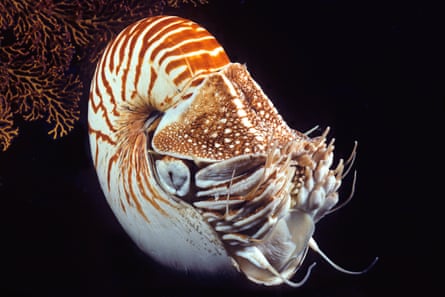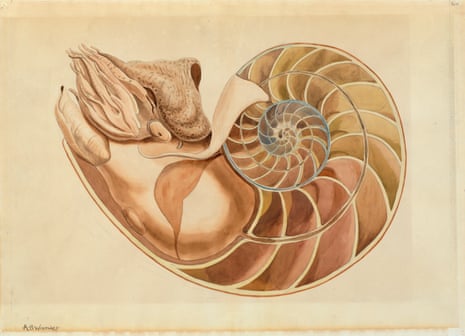Where to start with the nautilus: at the centre of the spiral or its culmination? Its eye works slowly, like a pinhole camera. It swims like a bellows. It can live for two decades, and its eggs take a year to hatch. It is a cephalopod in a shell, a spiral no wider than the length of a ruler, ending in 70 tentacle-like wavy bits. The tentacle-like bits are called cirri and they are very good at touch and smell.
One scientist describes it like this: “Right now everything’s in bloom, and, you know, you can smell the azaleas. But can you imagine if you could also say, ‘That azalea bush has 3,002 blossoms on it.’” (Their favourite things to touch and smell are not flowers but anything rotting.)
No matter how much I look at the nautilus, my brain cannot hold its image or understand its shape. To see the nautilus, I must look at a picture; it cannot be conjured to mind.
In one image, which shows just the empty shell, it looks a lot like those seashell chocolates: those exact shades of brown and cream, those patterns. My brain tries to think of it like a prawn curled up but that gets the face totally wrong, adds segments, and doesn’t make the right colours. Seen from the front, its face is like an anemone, if an anemone also looked like whiskers. From the side, its face looks a bit like a barn owl’s.
Its shell is a logarithmic or “marvellous” spiral, which means that as it turns, the distances between the turns grow in a geometric progression – think an IQ test, where you add the missing numbers in a sequence of increasing numbers. The nautilus shell winds in the same pattern as a hawk pursuing its prey, as an insect flying to the moon, as a cyclone seen from space, as the arms of some galaxies, including the Milky Way.
It is any spiral that seems to grow wider and wider and forget itself; open and flung out, like a thought growing faster, and larger, and grasping at more and more connected ideas. Then the thought is interrupted.

Nautiluses have been having thoughts of some kind for hundreds of millions of years. They have survived five mass extinctions. They can move from 700m deep to the surface of the ocean – 80 fewer “standard atmospheres” of pressure – “unfazed”.
How do you survive unfazed? You must live in a “strongly coiled, pearly shell”, and it must grow with you, chamber by chamber. Each new chamber is bigger than the last, and you move into it, sealing off the chamber behind you.
That is how to live, until you die. In his poem about the nautilus, Oliver Wendell Holmes put it like this: “Build thee more stately mansions, O my soul … Leave thy low-vaulted past! Let each new temple, nobler than the last, / Shut thee from heaven with a dome more vast, / Till thou at length art free”.
This article was amended to correct the depth at which a nautilus can function.
Helen Sullivan is a Guardian journalist. Her first book, a memoir called Freak of Nature, will be published in 2024

